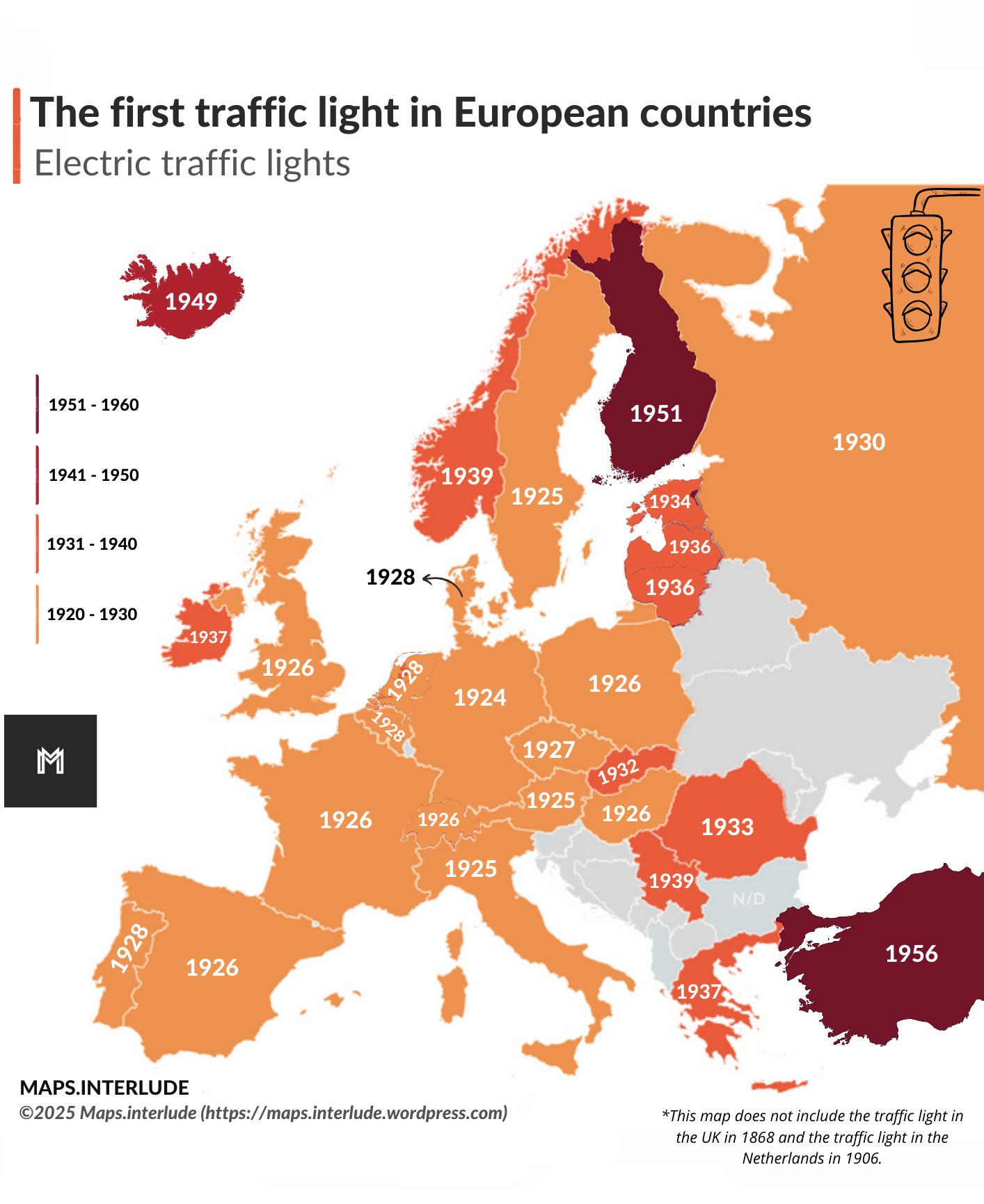First Traffic Light Locations Map in Europe


Marcus Rodriguez
Historical Geography Expert
Marcus Rodriguez specializes in historical cartography and geographic data analysis. With a background in both history and geography, he brings unique...
Geographic Analysis
What This Map Shows
This map outlines the locations of the first traffic lights installed in various European countries, providing a fascinating glimpse into the early days of urban transportation management. Traffic lights, as we know them today, are an essential part of our daily commutes, helping to regulate the flow of vehicles and pedestrians in bustling urban environments. However, their history traces back to the late 19th century, a time when cities were grappling with the challenges of increasing vehicular traffic. This visualization highlights not just when and where these signals were first placed, but also the social and technological contexts that gave rise to their implementation.
Deep Dive into Traffic Lights and Urban Mobility
Have you ever stopped to consider the impact traffic lights have on urban mobility? These seemingly simple devices play a crucial role in ensuring safety and order on our roads. The first traffic light was installed in London in 1868, functioning with gas lamps and manually operated signals. However, it was the advent of the electric traffic signal in the early 20th century that transformed road management.
Interestingly, these early traffic lights were not just about stopping and going; they represented a shift towards organized urban planning. As cities across Europe expanded and the number of automobiles surged, the need for systematic traffic control became apparent. For instance, the first electric traffic light was introduced in 1912 in Salt Lake City, USA, but it wasn't long before European nations followed suit. Cities like Paris and Berlin quickly adopted similar systems, recognizing the necessity of managing a growing urban population.
Traffic lights operate on a simple principle: they communicate the rules of the road. The red, yellow, and green signals each convey vital information to drivers and pedestrians. But what’s fascinating is how these signals vary in design and operation across different countries. For example, in some parts of Europe, additional signals indicate when it's safe for pedestrians to cross, emphasizing the importance of pedestrian safety in urban design.
The implementation of traffic lights also coincided with broader advancements in road safety and urban infrastructure. Countries began to invest more in road networks, signage, and public awareness campaigns about traffic rules. In fact, the introduction of the first traffic lights in various countries can be seen as a precursor to the complex traffic management systems we have today, which incorporate technology like sensors and automated traffic management systems.
Regional Analysis
When we look at the map, certain trends emerge regarding the adoption of traffic lights across Europe. The United Kingdom, for instance, was an early adopter, with the first traffic light in London paving the way for others. Meanwhile, countries like Germany and France followed closely, installing their first traffic lights in the early 20th century. Interestingly, the speed of adoption varied significantly by region.
In Southern Europe, for example, the integration of traffic lights was slower, often due to a reliance on roundabouts and different traffic management philosophies. Countries like Italy and Spain have traditionally favored these circular intersections, which can manage traffic flow without the need for lights in many cases. However, as urbanization has increased, these nations have gradually incorporated traffic lights into their infrastructure.
Scandinavian countries, on the other hand, adopted traffic control systems with a strong focus on pedestrian safety and environmental considerations. Cities in Sweden, for instance, are renowned for their innovative traffic solutions, which prioritize not just vehicle movement but also the well-being of pedestrians and cyclists.
Significance and Impact
The significance of understanding the history and distribution of traffic lights in Europe cannot be overstated. These devices have not only shaped urban mobility but have also influenced societal norms around road safety. As cities continue to grow and evolve, the role of traffic management tools becomes even more critical. With the rise of smart city initiatives, where technology is integrated into urban planning, the future of traffic management is likely to see even more advancements.
Current trends indicate a shift towards more sustainable transportation methods, with cities exploring alternatives such as traffic calming measures, expanded pedestrian zones, and improved public transit systems. As we move forward, understanding the historical context of traffic management, as illustrated by this map, can help us design better, safer urban spaces that accommodate both vehicles and pedestrians. Ever wondered how your daily commute might look in a future where traffic lights are replaced by advanced AI traffic systems? The possibilities are intriguing and worth exploring, as the evolution of urban mobility continues to unfold.
Visualization Details
- Published
- September 26, 2025
- Views
- 50
Comments
Loading comments...